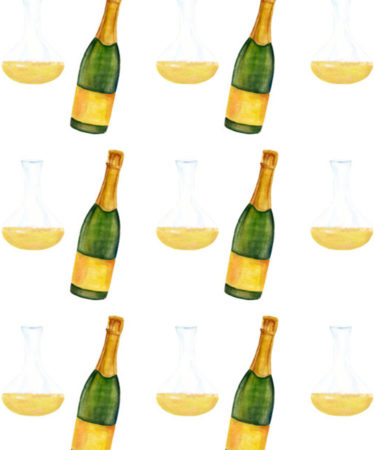
It’s a scene that could have taken place eight minutes ago or eight decades ago, in living color or on screen: a restaurant guest orders a bottle of Champagne. The sommelier sets glasses, presents the bottle and, upon approval, retreats to his or her station to remove the cork swiftly and silently. He or she returns, holding a bottle that is – wait a minute, is that bottle empty? And is the sommelier holding – it couldn’t be – a decanter? Did that sommelier just decant my Champagne??
With small-production Champagnes from grower-producers flooding the wine lists not only of pricey fine-dining establishments but of tiny, unassuming wine bars, decades-long notions of when and how to drink Champagne are changing. As sommeliers and consumers alike begin to see Champagne as wine first and sparkling wine second, they’re beginning to treat Champagne as a wine as well, now favoring a white-wine glass over a flute and drinking the bottle throughout the meal rather than simply as an aperitif or toast. And more sommeliers than ever are choosing to decant Champagne as they would a still wine, which brings up a few questions: why, when, and how?
Because the practice of decanting Champagne can be controversial, a sommelier will usually ask the guest before decanting the bottle, but it’s up to the sommelier to know when a certain Champagne might benefit from decanting. Whereas still wines are often decanted to remove sediment that may have collected, decanting Champagne is really all about oxygen. This has a lot to do with how the Champagne has been made. “Generally, there are two styles in which you can categorize Champagne: oxidative versus reductive,” notes Jack Mason, Master Sommelier and wine director at Marta. Reductive winemaking involves a winemaker taking steps to prevent oxygen from interacting with the wine, usually to promote fresh, fruity flavors, whereas oxidative winemaking is just the opposite. “[It’s the] more reduced or ‘reductive’ styles, such as the wines from Cédric Bouchard, that really see the aid of quick, gentle aeration,” says Mason. Decanting allows oxygen to interact with the Champagne, causing air-deprived aromas and flavors to blossom more quickly and “blow off” any reduced aromas that may be present, which can smell of rotten egg or struck match.
Don't Miss A Drop
Get the latest in beer, wine, and cocktail culture sent straight to your inbox.The notion of decanting Champagne isn’t just a practice among sommeliers; some Champagne producers believe that certain cuvées benefit from decanting as well. Noted Champagne house Billecart-Salmon encourages decanting some of its vintage Champagnes, particularly when younger, to allow these more complex wines to show their true character. “Decanting helps a younger vintage open up, gently calm down the effervescence, slightly increase in temperature and let the aromas develop and express themselves,” says Clément Calleja, the Eastern region manager for Billecart-Salmon US. However, use caution when considering the decanting of older vintage Champagnes; as they age post-disgorgement, Champagne bottles are already being exposed to oxygen. Since they tend to become more delicate over time, decanting could cause these older Champagnes to fall apart too quickly.
Pairing Champagne With Your Meal
Since more wine lovers are now choosing to drink Champagne throughout their meals rather than just before them, decanting Champagne can also help give the wine a more food-friendly texture, softening the sometimes-aggressive bubbles in young Champagne. And while some might argue that it is preferable to allow Champagne to open up naturally in the glass, this may simply not be practical in a group-dinner setting, as guests will likely finish their glasses before the Champagne has had a chance to reach its best. “It could be somewhat frustrating to realize the glass is empty when the wine was just starting to change tremendously,” Calleja points out.
But of course, one must consider the effects on possibly the most beloved part of Champagne: the bubbles. Won’t the movement and exposure to oxygen make the Champagne less sparkling? In short, yes, which is why some sommeliers choose not to decant Champagne. “I generally don’t like decanting Champagne unless it is for practical reasons [such as being] hard to pour from a Nebuchadnezzar,” says Laura Maniec, Master Sommelier and CEO of Corkbuzz. “I think decanting does make the bubbles dissipate quicker than if just in the bottle.” However, that’s not necessarily a bad thing. Mason asserts: “With some young Champagnes, softening the bubbles can be a benefit as it softens the wine and increases its quaff-ability.” In order to minimize loss of effervescence, Calleja recommends decanting just before serving into a tall, narrow decanter; Billecart-Salmon actually makes a special Champagne decanter shaped like its signature rosé bottle.
How To Decant Champagne
Now, for the technique. Champagne, unsurprisingly, tends to bubble up and over the decanter quite quickly, so Mason has a trick: rinse the inside of the decanter with a small amount of Champagne, coating the inner surface. This will help reduce foaming. Then it’s all about decanting gently, tilting the decanter at a slight angle and pouring slowly down the side, “similar to when you begin pouring beer in a glass,” says Mason. If the Champagne threatens to foam over, simply pause and let the bubbles settle. Voila! Now, not only have you got a beautifully aerated Champagne, but a showpiece as well. (Pro tip: a regular ol’ tall vase will work as a decanter, too.)
While your grandmother may have been shocked at the idea of decanting Champagne, she probably also would be shocked at the notion of casually enjoying a bottle on a random Tuesday evening. As both availability and perceptions of Champagne change (for the better), so must service of this French classic. Get ready to blow everyone’s minds at your next dinner party, bubbly-style.
